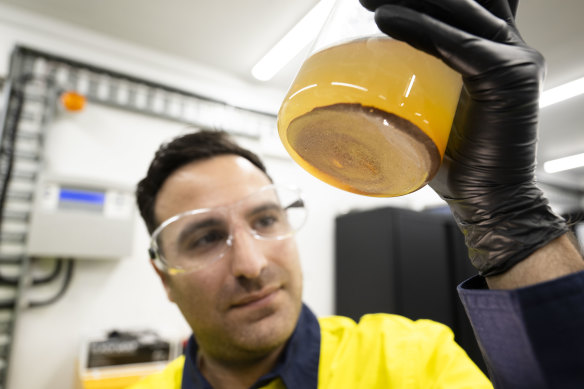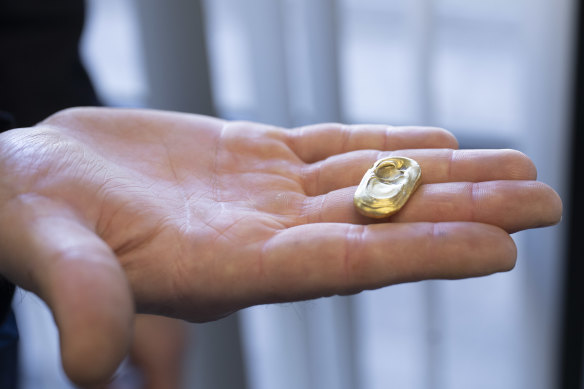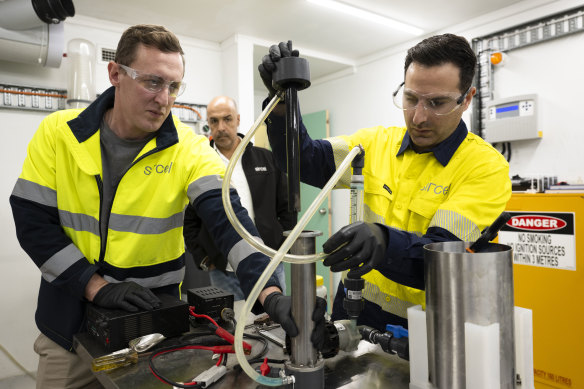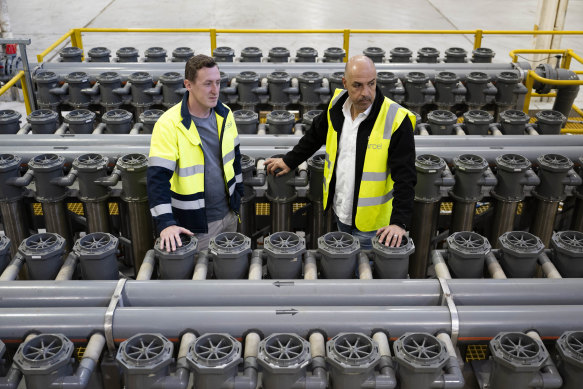- Exclusive
- Environment
- Sustainability
- Recycling
This was published 8 months ago
The secret facility extracting gold from electronic waste
At a secret electronic waste recycling facility somewhere in Australia, a team of metallurgists extracts gold, silver and copper from the remains of old laptops, phones and other electronics.
The precious metals recovery is chemistry, not alchemy, but many of the exact processes are trade secrets. Even the location of the facility is secret.

Sircel metallurgist David Bension extracting gold at a secret e-waste recycling facility.Credit: Janie Barrett
It is the final stage of recycling and the most lucrative for Sircel, which is now Australia’s largest e-waste processor after it bought assets from Melbourne-based Scipher Technologies for $5 million this year.
It is also the only part of the recycling process done by hand. Sircel’s other operations in NSW, Victoria and Queensland are highly mechanised and feature specialised machines that break apart electronics and separate them into components.
Sircel chief executive Anthony Karam said most e-waste recycling in Australia involved people manually dismantling machines, but this could not provide the scale needed.

Sircel metallurgist David Bension with a gold nugget extracted from e-waste.Credit: Janie Barrett
“When you’re talking about Australia generating in the hundreds and hundreds of thousands of tonnes of waste per year, there needs to be facilities and businesses like ours, where you can actually do 20 to 30 tonnes a day at a particular site.”
There is no national data collection on e-waste, but federal government estimates suggest Australia will generate 614,000 tonnes of e-waste a year in 2025, excluding large household appliances. That’s nearly 25 kilograms per person.
This masthead was taken behind the scenes at Sircel’s two Villawood sites and the third secret facility to see how the company is recycling 100 per cent of e-waste. It’s an achievement 5½ years in the making, and there will be a formal opening this year.
E-waste arrives at Villawood from councils, e-waste collection points, and corporate, government and retail partners. Some companies deal only in valuable products such as computers or mobile phones, but Karam said Sircel accepted “anything with a battery or a plug”.
First, anything usable is taken to be refurbished and resold. Batteries are stored in a fire-proof container and taken to another provider for recycling.
Everything else is crushed in Sircel’s machines and mechanically separated into components: plastics from metals, and plastic pieces into colours, and metals into different types. This includes iron, stainless steel, aluminium, copper, brass, gold, silver and small streams of lead and tin.
There is further mechanical refining at a second Villawood site across the road, and materials containing precious metals are taken to another site elsewhere in the state.
Sircel also has a recycling facility in Parkes that specialises in solar panels, one in Dandenong that does general e-waste and televisions, and one in Brisbane similar to Villawood.

Sircel chief executive Anthony Karam (centre) looks on while metallurgists Adam Roper and David Bension extract copper.Credit: Janie Barrett
The World Health Organisation says e-waste is the fastest-growing solid waste stream in the world, increasing three times faster than the world’s population. Less than a quarter of e-waste produced globally in 2019 was known to be formally recycled, while the rest either went to landfill or was poorly recycled, contaminating the environment with toxic chemicals such as dioxins, cadmium, lead and mercury.
Karam said he went to one of the most notorious e-waste sites, Agbogbloshie in Ghana, several years ago, before it was shut down by the Ghanaian government in 2021.
“As far as you can see was piles and piles of e-waste, and it was literally being burned off for copper wires and so on,” Karam said. “I think the average life expectancy of a male in that area was something like 43 – it was really bad.”
Karam said the Australian government should ban e-waste from being exported in favour of homegrown solutions.

Sircel chief executive Anthony Karam and metallurgist David Bension at the e-waste recycling facility.Credit: Janie Barrett
Under the Basel Convention, Australia allows the export of hazardous waste, including e-waste, with a permit. Sustainability Victoria says materials such as batteries and circuit boards are sent to South Korea or Singapore for final processing.
Keeping the materials in Australia would also mean more of the valuable materials being used for remanufacturing – a key plank of the circular economy. Government figures suggest that Australia recovers only one-third of the value of e-waste materials – $430 million in 2019.
The figures suggest large household appliances have good recycling rates because of the high metal content, while three out of four television and computer products were recycled in 2023-24 under the National Television and Computer Recycling Scheme. Solar panels are the fastest-growing e-waste stream in Australia, with 3000 tonnes generated in Australia in 2019 and only 6 per cent of the materials recovered.
The Australian Financial Review reported that Sircel bought parts of Melbourne-based Scipher Technologies after it went into administration in March. Scipher Technology was funded $7.5 million apiece from the Clean Energy Finance Corporation and the Australian Business Growth Fund in 2022.
Get to the heart of what’s happening with climate change and the environment. Sign up for our fortnightly Environment newsletter.